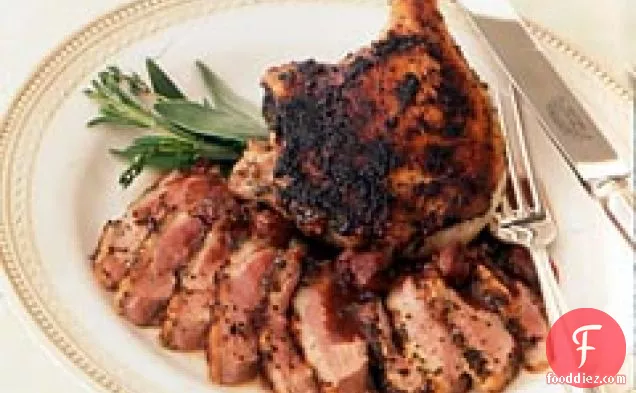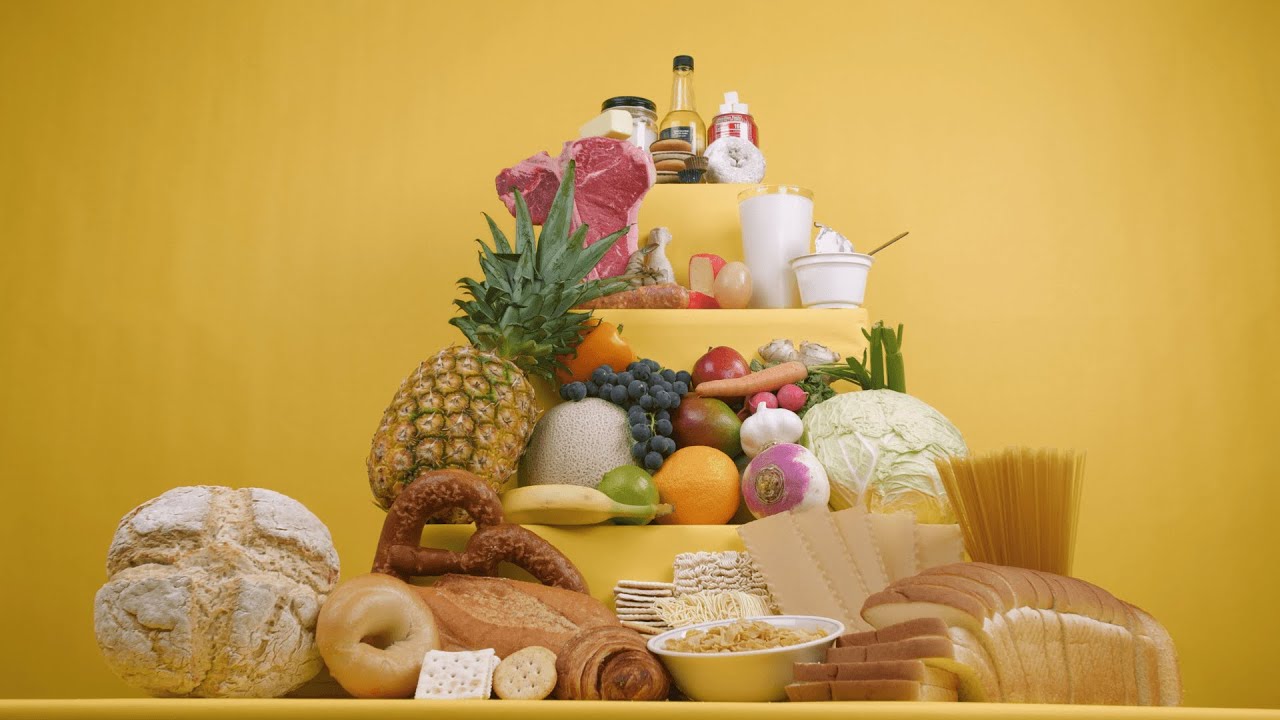Herb-Rubbed Duck with Tart Cherry and Sage Sauce

Herb-Rubbed Duck with Tart Cherry and Sage Sauce might be just the main course you are searching for. This gluten free and dairy free recipe serves 8. One serving contains 5844 calories, 164g of protein, and 562g of fat. Only From preparation to the plate, this recipe takes roughly 45 minutes. A mixture of onion, full-bodied wine, rosemary leaves, and a handful of other ingredients are all it takes to make this recipe so flavorful. To use up the vegetable oil you could follow this main course with the Blueberry Coffee Cake #SundaySupper as a dessert.
Instructions
1
Herb rub. If using fresh bay leaves, pull out the center veins.
Ingredients you will need![Fresh Bay Leaves]() Fresh Bay Leaves
Fresh Bay Leaves![Dry Seasoning Rub]() Dry Seasoning Rub
Dry Seasoning Rub
2
Combine all the ingredients for the herb rub in a spice mill or blender and grind to a coarse paste.
Ingredients you will need![Dry Seasoning Rub]() Dry Seasoning Rub
Dry Seasoning Rub
Equipment you will use![Blender]() Blender
Blender
4
Cut up the ducks by removing the 2 legs and the 2 boneless breasts (with skin) from each bird. Reserve the necks and carcasses. Score the skin on the breasts by drawing a very sharp knife across the skin in a diagonal crisscross pattern, 4 or 5 lines in each direction. Be careful to cut only into the skin and not into the flesh. This helps render the fat quickly when the breasts are cooked. Rub the duck breasts and legs with the herb paste as evenly as you can, rubbing some inside the scored cuts.
Ingredients you will need![Duck Breast]() Duck Breast
Duck Breast![Duck]() Duck
Duck![Dry Seasoning Rub]() Dry Seasoning Rub
Dry Seasoning Rub
Equipment you will use![Knife]() Knife
Knife
5
Put them in a medium bowl, cover, and let marinate in the refrigerator for at least 3 hours or as long as 24 hours.
Equipment you will use![Bowl]() Bowl
Bowl
7
Cut the wings off the duck carcasses, remove as much skin and fat as comes off easily, and cut the carcasses in half (you can bend them until they snap, then cut between bones, or use a cleaver). You should now have 4 wings, 4 pieces of carcass, and 2 necks.
Ingredients you will need![Chicken Wings]() Chicken Wings
Chicken Wings![Whole Duck]() Whole Duck
Whole Duck
Equipment you will use![Cleaver]() Cleaver
Cleaver
8
Heat the oil in a large (6- to 8-quart) heavy-bottomed pot over high heat.
Ingredients you will need![Cooking Oil]() Cooking Oil
Cooking Oil
Equipment you will use![Pot]() Pot
Pot
9
Add these 10 pieces to the pot and brown them for 10 to 12 minutes, turning once or twice. This step is important for building flavor in the stock but not all of the surfaces need to be evenly brown.
Ingredients you will need![Stock]() Stock
Stock
Equipment you will use![Pot]() Pot
Pot
10
Pour off the fat that has accumulated in the pan, then pour in enough cold water to barely cover the bones. Bring the stock to a boil, turn the heat to very low, and skim off any fat or foam that rises to the surface.
Ingredients you will need![Stock]() Stock
Stock![Water]() Water
Water
Equipment you will use![Frying Pan]() Frying Pan
Frying Pan
11
Add the onion, carrot, celery, thyme, and bay leaves and gently simmer uncovered for 2 to 3 hours.
Ingredients you will need![Bay Leaves]() Bay Leaves
Bay Leaves![Carrot]() Carrot
Carrot![Celery]() Celery
Celery![Onion]() Onion
Onion![Thyme]() Thyme
Thyme
12
Sauce. Strain the stock, discard the bones, and return the stock to the pot.
Ingredients you will need![Sauce]() Sauce
Sauce![Stock]() Stock
Stock
Equipment you will use![Pot]() Pot
Pot
13
Add the wine, shallot, and cherries. Boil the sauce until it is thickened and reduced to about 2 cups, 45 to 60 minutes. (The sauce can be made a day ahead and refrigerated for up to 2 days.)
Ingredients you will need![Cherries]() Cherries
Cherries![Shallot]() Shallot
Shallot![Sauce]() Sauce
Sauce![Wine]() Wine
Wine
14
Roasting the legs. Preheat the oven to 425°F. About 45 minutes before serving, heat a large (10- to 12-inch) ovenproof skillet (cast iron works well) over medium-high heat.
Equipment you will use![Frying Pan]() Frying Pan
Frying Pan![Oven]() Oven
Oven
16
Add the duck legs skin side down and cook until the skin side browns, 4 to 5 minutes. Without turning the legs over, put the pan in the oven and roast for 10 minutes. Turn the duck legs and continue to roast until the skin is very brown and crisp and the meat is tender when pierced with a fork, about 20 minutes longer.
Ingredients you will need![Duck Leg]() Duck Leg
Duck Leg![Meat]() Meat
Meat
Equipment you will use![Oven]() Oven
Oven![Frying Pan]() Frying Pan
Frying Pan
18
Sautéeing the breasts. When the legs have been in the oven for 20 minutes, begin to cook the breasts.
Equipment you will use![Oven]() Oven
Oven
19
Pour a thin film of oil into another large (12-inch) skillet and heat it over medium heat until hot.
Ingredients you will need![Cooking Oil]() Cooking Oil
Cooking Oil
Equipment you will use![Frying Pan]() Frying Pan
Frying Pan
20
Add the duck breasts skin side down, reduce the heat to medium-low, and let cook slowly and undisturbed. After 5 minutes, about 1/2 inch of fat will have rendered into the pan, which will help render the remaining fat from under the skin. Continue to cook the breasts until the skin is very brown and crisp, another 5 to 10 minutes. If the rendered fat rises above the level of the skin and the duck meat begins to be submerged, pour some of it off into a small bowl. This will prevent the breast meat from overcooking before the skin is crisp. When the skin is crisp but not blackened, turn the breasts over and cook just 1 minute for rare or 2 to 5 minutes for medium-rare to medium. The meat should feel firm but still springy and an instant-read thermometer inserted horizontally into the breast should register 120°F to 125°F for rare, 130°F to 135°F for medium-rare to medium. The temperature will continue to rise about 10° as they rest.
Ingredients you will need![Duck Breast]() Duck Breast
Duck Breast![Whole Duck]() Whole Duck
Whole Duck![Meat]() Meat
Meat
Equipment you will use![Kitchen Thermometer]() Kitchen Thermometer
Kitchen Thermometer![Bowl]() Bowl
Bowl![Frying Pan]() Frying Pan
Frying Pan
21
Transfer them to the plate with the legs and let them sit on the back of the stove for 4 to 5 minutes before carving.
Equipment you will use![Stove]() Stove
Stove
22
Finishing. Bring the sauce to a simmer and stir in the chopped sage, thyme, and balsamic vinegar. Taste and season with salt and pepper as needed. Arrange the duck legs on a warmed platter or individual plates. Using a sharp thin knife, slice the breasts on a diagonal 3/8 inch thick and arrange the slices in a fan shape leaning against the legs.
Ingredients you will need![Balsamic Vinegar]() Balsamic Vinegar
Balsamic Vinegar![Salt And Pepper]() Salt And Pepper
Salt And Pepper![Duck Leg]() Duck Leg
Duck Leg![Sauce]() Sauce
Sauce![Thyme]() Thyme
Thyme![Sage]() Sage
Sage
Equipment you will use![Knife]() Knife
Knife
24
Resembling giant raisins, sweet and sour varieties of dried cherries from Yakima Valley in Washington are exciting and relatively new ingredients. Dried sweet cherries have a prunelike flavor, but the tart (sour or pie) cherries, which are usually processed with sugar, have a brilliant tangy flavor. When simmered with wine and duck stock, they make a balanced, savory, and full-flavored sauce that plays beautifully off the crispy citrus-rubbed duck in this recipe.
Ingredients you will need![Dried Cherries]() Dried Cherries
Dried Cherries![Cherries]() Cherries
Cherries![Raisins]() Raisins
Raisins![Sauce]() Sauce
Sauce![Stock]() Stock
Stock![Sugar]() Sugar
Sugar![Whole Duck]() Whole Duck
Whole Duck![Wine]() Wine
Wine
Ingredients
2teaspoons![balsamic vinegar]() balsamic vinegar2
balsamic vinegar2![bay laurel leaves,fresh or dried]() bay laurel leaves,fresh or dried2teaspoons
bay laurel leaves,fresh or dried2teaspoons![freshly ground black pepper]() freshly ground black pepper1small
freshly ground black pepper1small![carrot, coarsely chopped]() carrot, coarsely chopped1rib
carrot, coarsely chopped1rib![celery, coarsely, chopped]() celery, coarsely, chopped237milliliters
celery, coarsely, chopped237milliliters![dried tart cherries (see Note)]() dried tart cherries (see Note)59milliliters
dried tart cherries (see Note)59milliliters![fresh rosemary leaves]() fresh rosemary leaves2Tbsps
fresh rosemary leaves2Tbsps![finely chopped fresh sage]() finely chopped fresh sage473milliliters
finely chopped fresh sage473milliliters![full-bodied red wine, such as Cabernet Sauvignon or Merlot]() full-bodied red wine, such as Cabernet Sauvignon or Merlot4teaspoons
full-bodied red wine, such as Cabernet Sauvignon or Merlot4teaspoons![juniper berries]() juniper berries1small
juniper berries1small![onion, coarsely chopped]() onion, coarsely chopped1
onion, coarsely chopped1![Thinly sliced zest of orange (removed with a zester)]() Thinly sliced zest of orange (removed with a zester)2teaspoons
Thinly sliced zest of orange (removed with a zester)2teaspoons![salt]() salt8servings
salt8servings![Salt and freshly ground black pepper]() Salt and freshly ground black pepper79milliliters
Salt and freshly ground black pepper79milliliters![medium shallot, finely chopped (about]() medium shallot, finely chopped (about1teaspoon
medium shallot, finely chopped (about1teaspoon![finely chopped fresh English thyme]() finely chopped fresh English thyme2Tbsps
finely chopped fresh English thyme2Tbsps![fresh English thyme leaves]() fresh English thyme leaves2Tbsps
fresh English thyme leaves2Tbsps![vegetable oil]() vegetable oil11kilograms
vegetable oil11kilograms![whole 5-pound ducks, Peking or Muscovy]() whole 5-pound ducks, Peking or Muscovy
whole 5-pound ducks, Peking or Muscovy
 balsamic vinegar2
balsamic vinegar2 bay laurel leaves,fresh or dried2teaspoons
bay laurel leaves,fresh or dried2teaspoons freshly ground black pepper1small
freshly ground black pepper1small carrot, coarsely chopped1rib
carrot, coarsely chopped1rib celery, coarsely, chopped237milliliters
celery, coarsely, chopped237milliliters dried tart cherries (see Note)59milliliters
dried tart cherries (see Note)59milliliters fresh rosemary leaves2Tbsps
fresh rosemary leaves2Tbsps finely chopped fresh sage473milliliters
finely chopped fresh sage473milliliters full-bodied red wine, such as Cabernet Sauvignon or Merlot4teaspoons
full-bodied red wine, such as Cabernet Sauvignon or Merlot4teaspoons juniper berries1small
juniper berries1small onion, coarsely chopped1
onion, coarsely chopped1 Thinly sliced zest of orange (removed with a zester)2teaspoons
Thinly sliced zest of orange (removed with a zester)2teaspoons salt8servings
salt8servings Salt and freshly ground black pepper79milliliters
Salt and freshly ground black pepper79milliliters medium shallot, finely chopped (about1teaspoon
medium shallot, finely chopped (about1teaspoon finely chopped fresh English thyme2Tbsps
finely chopped fresh English thyme2Tbsps fresh English thyme leaves2Tbsps
fresh English thyme leaves2Tbsps vegetable oil11kilograms
vegetable oil11kilograms whole 5-pound ducks, Peking or Muscovy
whole 5-pound ducks, Peking or MuscovyDifficultyExpert
Ready In45 m.
Servings8
Health Score6
Related recipes
Spinach Bow Tie Pasta Salad
Double-Crust Pear Pie
Southwestern Chicken Soup
Tabbouleh Salad with Shrimp
Magazine

Your Inner Chef with Taylor Swift's Top 3 Recipes from Her Beloved NYC Hangout

20 Mouthwatering Recipes You Need to Try Today!

Master the Art of Making Perfect Pancakes with This Foolproof Recipe

The Science Behind Red Wine: Its Surprising Health Benefits and Potential Risks

12 Wine Cocktails for a Sophisticated Twist

Sip, Swirl, and Celebrate: Toasting to National Wine Day on May 25th

National Drink Wine Day on February 18

Celebrating Souffle Day with Delectable Delights

Indulge in the Delightful Flavor of Oyster Soup on Its Special Day!

Celebrating World Nutella Day

How to Make the Perfect Birthday Cake

How to Debone a Chicken

How to Get Started with Healthy Cooking

12 Spring Vegetarian Recipes

15 Tasty Dessert Recipes

20 Best Breakfast Ideas to Enjoy this Spring

12 Healthy Spring Menu Ideas for 2022

Celebrate Spring with 3 Fresh Dishes

10 Healthy Springtime foods and How to Prepare Them

5 Simple Guidelines to Demystify 'Seasonal Cooking'

20 Mouthwatering Recipes You Need to Try Today!

These Super Recipes for Your Football Party!

Celebrate National Pizza Day on February 9th with Mouthwatering Slices and Fun Facts

Vegetarian soup recipes are not just for vegetarians anymore

Understanding the Science Behind the Keto Diet

Secrets of the Food Pyramid: A Journey Through its Intriguing History

The Future of Nutritionthe New and Improved Food Pyramid

The Rich and Flavorful Black Food Traditions in Netflix's 'High on the Hog'

Vibrant World of South Asian Food Trucks at the Mississauga Festival








